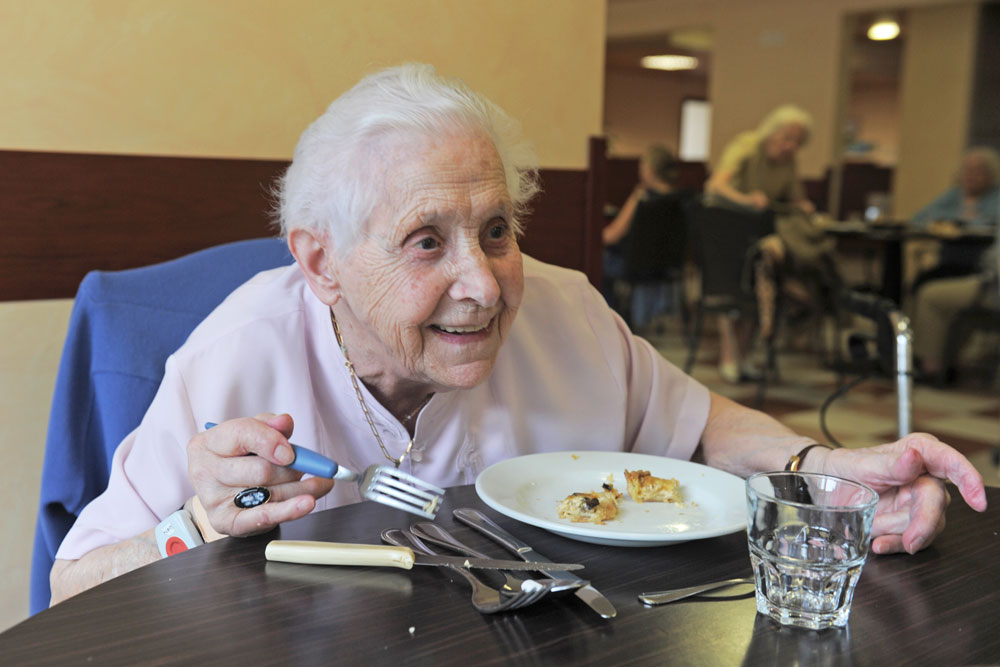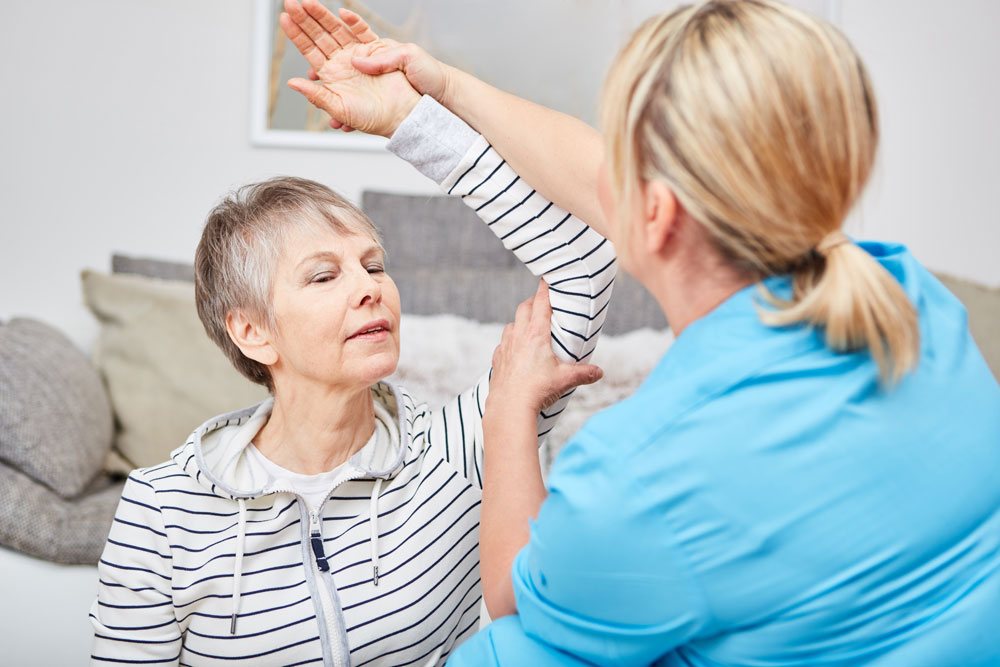The value base must be what guides the development work of elderly care.
This article is written from a Swedish perspective. Hopefully, it can inspire those interested from other countries.
As the population ages, it becomes increasingly important to implement preventative measures to reduce the need for nursing homes. By providing support and resources for older people, society can help maintain their independence and quality of life. Below, we explore various strategies and measures that can help prevent the need for older people to move into nursing homes.
 Foto: Mostphotos
Foto: MostphotosWhat are efficiency improvements in elderly care, really?
Sometimes people talk about making elderly care more efficient. The approach to a more efficient elderly care differs greatly depending on whether the aim is to save money or to create more time for the residents. Efficiency can also be achieved at the societal level. This means that the elderly can stay in their homes and lead an independent life with limited support services.
The starting point for the efficiency measures implemented today is often to save money for taxpayers or increase the bottom line profit. This often leads to cutting corners. Elderly care requires extensive knowledge among the staff in order to meet the residents' needs. When time for reporting and training is removed, the conditions for development, leadership, and control are slowly but surely undermined.
There is a risk of focusing too much on costs. Making changes that lower the quality often leads to higher costs in the long run. For a nursing home, this can result in more hospitalizations, increased staff turnover, increased number of complaints, and time-consuming investigations of Lex Sarah and Lex Maria (Swedish laws to prevent care injuries and deficiencies in care). Added to this is often increased suffering for residents and their relatives.
Measuring the cost of a nursing home is therefore not easy. It's easy to look at one's own wallet and forget how the community around is affected. There is no direct correlation between cost and quality. There are nursing homes that deliver high quality care with low costs, just as there are nursing homes with high costs and poor quality. Anyone who only looks at costs and does not work simultaneously with the quality of the operation risks making serious mistakes.
All operational changes must be preceded by a thorough analysis of the current state and why. Before changes are made, a risk analysis also needs to be completed.
One way to work with operational development is to compare oneself with others. Units can learn from each other to find ways to work smarter. One way to improve quality and save time in the long run is to work functionally. Likewise, a good fall injury prevention work is a way to avoid fractures and other healthcare injuries. By comparing oneself with others, the operation can also gain inspiration to raise its own ambition level.
Leadership with a clear vision can often find ways to improve quality with existing resources. Quality is created by the staff in the meeting with the residents and their relatives. A clear and ambitious leadership with a clear vision often creates job satisfaction and engagement among employees who want to be able to feel proud of their workplace. Aiming to be the best is in the nature of good leadership.
Operations with poor results need to invest in doing a thorough analysis of what is holding the operation back. Especially in larger cities, nursing homes will experience tougher competition for the elderly. If there is an excess of accommodation places, the elderly and their relatives will vote with their feet and choose the nursing home with the best reputation and offerings.
The absolute largest cost in elderly care is the staff. If the staff does not enjoy and engage in the operation, the quality drops while costs increase. The change can happen quickly.
Better quality in elderly care means a win-win where it gets better for the residents and their relatives while giving the staff more meaningful work.
Preventing increased care needs
Often, the move to a nursing home begins with a hospital stay. The elderly person may have fallen or gotten a urinary tract infection that requires hospital care. Often, one can see underlying causes such as malnutrition, loneliness problems or the onset of dementia.
Home care:
By offering comprehensive home care services, elderly people can receive support and assistance with everyday activities in their own home. This can include personal care, household chores, cooking and medical supervision, enabling them to stay in a safe and familiar environment for longer. Working to preserve function and providing good support for the elderly to get the nutrition they need are central quality factors in effective home care.
Adapting homes:
Adapting the homes of the elderly to meet their needs and physical limitations can help increase their independence and reduce the risk of injuries. This can include the installation of handicap adaptations, non-slip surfaces, handles and other aids to facilitate daily life. There are also good digital tools to facilitate safe contact with loved ones.
Social and cultural engagement:
Promoting social and cultural activities for elderly people can help counteract feelings of isolation and loneliness. By offering meeting places, community activities, cultural events, and hobby groups, the elderly can have the opportunity to create meaningful relationships and continue participating in society.
Wellness and health promotion activities:
Promoting physical activity, healthy diet, and regular health checks can help maintain the physical and mental well-being of the elderly. By offering access to exercise groups, walking groups, health lectures, and nutrition advice, the community can support elderly people in leading an active and healthy life. Knowledge and learning are important health factors for the elderly.
Adapted transport services:
Providing adapted transport services for elderly people can make it easier for them to get to doctor appointments, shops, and social activities. This can include rides to and from nursing homes, public buses, and specially adapted transport for people with disabilities. Also, aids for disabled people such as mobility scooters increase the chances of an active life.
Support for relatives and caregivers:
Offering support and resources to relatives and caregivers who take care of elderly people at home can facilitate their care work and reduce their burden. This can include financial support, respite services, advice and training on care and care.
By working with preventive measures, society can contribute to promoting the health, independence, and quality of life of the elderly and thereby reduce the need for nursing homes. It is an investment in both individuals' well-being and the long-term sustainability of society.
Effective Elderly Care: A Necessity for Society
Elderly care is a central part of a functioning society and requires strategic and efficient management to meet the needs of the elderly population. In a time when the proportion of the elderly is increasing, it is important to understand and implement effective measures to ensure high-quality and accessible elderly care.
Long-term investments:
Effective elderly care requires long-term investments from society. This means providing sufficient resources to finance various aspects of elderly care, including staff, infrastructure, and technology. Central to patient safety in nursing homes are competence, leadership, and continuity. It is easy to undermine the quality of a nursing home with short-term savings. It can cost a lot of money and suffering to rebuild quality in an operation with quality deficiencies.
Person-centered care:
Focusing on individual needs and desires is crucial for effective elderly care. By offering person-centered care, each elderly person can be ensured the care and support that is best suited to their unique situation.
Cooperation and collaboration:
Effective elderly care requires close cooperation between various actors, such as healthcare professionals, relatives, volunteer organizations, and authorities. By cooperating, knowledge and resources can be exchanged to maximize the efficiency and quality of care.
Access to different care options:
An effective elderly care system should offer different care options for the elderly population, including home care, daytime activities, nursing homes, and advanced medical care. This gives people the opportunity to choose the form of care that best suits their needs and preferences.
Continuous evaluation and improvement:
By regularly evaluating and improving the quality and efficiency of elderly care, it can be ensured that it meets the current needs of the elderly population. This can include using evidence-based methods, implementing new technologies, and listening to feedback from both the elderly and their caregivers.
Supporting staff:
Recruiting and retaining qualified staff is crucial for effective elderly care. By offering competitive salaries, opportunities for continued education, and a positive work environment, staff can be supported in delivering high-quality care and service to the elderly.
In conclusion, effective elderly care is crucial for a functioning society. By investing in long-term solutions, focusing on person-centered care, promoting cooperation and collaboration, offering various care options, continuously evaluating and improving, and supporting staff, we can ensure that the elderly population receives the care and service they deserve.
Reflection questions - effective care
Care staff:
- Does the preventive elderly care work well in your area?
- Do you have a good dialogue with home care in the area?
- Do you get good handover in connection with moving in so that you can quickly create good care?
Manager, nurse, occupational therapist and physiotherapist:
- Do you have a good interaction with your local area when it comes to the quality of support for the elderly?
- Is there any analysis of who is moving into the nursing home and whether preventive measures could have postponed the move?
Residents and relatives:
- Could the move to a nursing home have been postponed with preventive measures?
Erland Olsson
Specialist Nurse
Sofrosyne
Better care every day

Aktuellt i media
- 2024-04-25 04:00 04 Bemötande
- 2024-04-22 04:00 01 Kvalitet
- 2024-04-18 04:00 10 Aktivitet o funktionsbevarande arbetssätt
-
2024-04-15 04:00
09 Mat och måltid
Food and fall prevention. How the nursing home ensures a safe and nutritious food handling.
info Foto: Mostphotos
Foto: Mostphotos - 2024-04-11 04:00 05 Planering
- 2024-04-08 04:00 10 Aktivitet o funktionsbevarande arbetssätt






